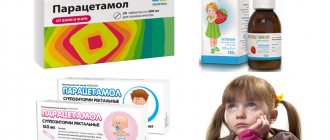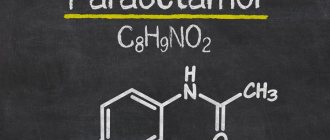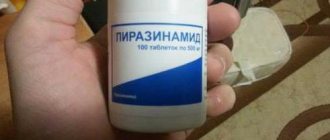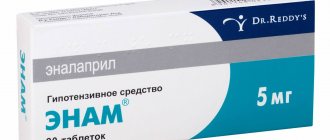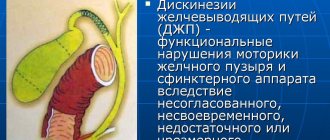Medicinal properties
The medication belongs to the group of non-narcotic analgesics, with moderate analgesics, weak anti-inflammatory properties and pronounced antipyretic effects. The drug has the property of blocking COX-1 and COX-2 in the central nervous system, while changing body temperature. Easily penetrates the BBB, absorption in the stomach occurs quickly and almost completely, reaching peak concentration in the blood plasma 30-120 minutes after ingestion. Poorly penetrates into breast milk. Processed in the liver. In large quantities (more than 10 grams per day) it reduces glutathionine reserves in the liver. It is predominantly excreted through the kidneys; about 3% may be excreted unchanged.
Paracetamol-UBF
From the skin: itching, rash on the skin and mucous membranes (usually erythematous, urticaria), angioedema, exudative erythema multiforme (including Stevens-Johnson syndrome), toxic epidermal necrolysis (Lyell's syndrome).
From the side of the central nervous system (usually develops when taking high doses): dizziness, psychomotor agitation and disorientation.
From the digestive system: nausea, epigastric pain, increased activity of liver enzymes, usually without the development of jaundice, hepatonecrosis (dose-dependent effect).
From the endocrine system: hypoglycemia, up to hypoglycemic coma.
From the hematopoietic organs: anemia, sulfhemoglobinemia and methemoglobinemia (cyanosis, shortness of breath, heart pain), hemolytic anemia (especially for patients with glucose-6-phosphate dehydrogenase deficiency). With long-term use in large doses - aplastic anemia, pancytopenia, agranulocytosis, neutropenia, leukopenia, thrombocytopenia.
From the urinary system: (when taking large doses) - nephrotoxicity (renal colic, interstitial nephritis, papillary necrosis). Overdose. Symptoms (acute overdose develops 6-14 hours after taking paracetamol, chronic - 2-4 days after exceeding the dose) of acute overdose: dysfunction of the gastrointestinal tract (diarrhea, loss of appetite, nausea and vomiting, abdominal discomfort and/or pain in stomach), increased sweating.
Symptoms of chronic overdose: a hepatotoxic effect develops, characterized by general symptoms (pain, weakness, adynamia, increased sweating) and specific ones characterizing liver damage. As a result, hepatonecrosis may develop. The hepatotoxic effect of paracetamol may be complicated by the development of hepatic encephalopathy (thought disturbances, central nervous system depression, stupor), convulsions, respiratory depression, coma, cerebral edema, hypocoagulation, development of disseminated intravascular coagulation syndrome, hypoglycemia, metabolic acidosis, arrhythmia, collapse. Rarely, liver dysfunction develops suddenly and can be complicated by renal failure (renal tubular necrosis).
Treatment: administration of SH-group donors and precursors for the synthesis of glutathione - methionine 8-9 hours after an overdose and N-acetylcysteine - after 12 hours. The need for additional therapeutic measures (further administration of methionine, intravenous administration of N-acetylcysteine) is determined in depending on the concentration of paracetamol in the blood, as well as on the time elapsed after its administration.
Mode of application
The tablets should be taken orally with water. For adults, the average dose is 500 mg 2-3 times a day. You should not drink more than 1 gram at a time, and more than 4 grams per day. To relieve pain, you should not take it for more than five days in a row, and to reduce fever - no more than three days in a row. For patients with congenital hyperbilirunemia, with impaired hepatic and renal functions and at retirement age, the dose is 2 times reduced from the standard recommended.
For children, a dosage is selected at the rate of 10-15 milligrams per kilogram of weight 2 times a day and no more than 4 times a day. For them, it is better to use a children's dosage of 200 mg per tablet.
Indications and contraindications for use
It is recommended to use Paracetamol UBF if you are concerned about:
- pain, including post-traumatic pain;
- fever with chills, high temperature during inflammatory and infectious processes in the body;
- algodismenorrhea accompanied by painful menstruation in women;
- migraine sensation;
- unspecified myalgia;
- manifestation of neuralgia, neuritis;
- manifestation of arthralgia
- sore throat.
Absolute negative impacts:
- private immunity of the active substance;
- hemophilia, a blood disease;
- decreased functionality of the liver and kidneys;
- children under 2 years old;
- adults over 65 years of age
- hereditary lack of glucose-containing substances;
- Gilbert's syndrome.
Cautious use is recommended for patients with Rotor and Johnson syndrome accompanied by constitutional or congenital hyperbilirubinemia. Also for patients with kidney and liver failure, hepatitis caused by a virus, liver enlargement under the influence of alcohol, diabetes mellitus (in the form of syrup).
Analogs
Efferalgan
Bristol Myers Squib, France
The average price in Russia is 105 rubles per package.
Efferalgan is a complete analogue of the active substance, but the release forms are completely different. For adults, effervescent tablets are available that are less damaging to the stomach and are absorbed more efficiently. Children drink sweet syrup, and there are also suppositories for rectal administration.
Pros:
- Effectively
- Relatively inexpensive.
Minuses:
- Not suitable for everyone
- No regular pills.
Ibuprofen
Hemofarm, Serbia
The average price in Russia is 52 rubles per package.
Ibuprofen is a non-steroidal anti-inflammatory drug, available in tablet form, which effectively reduces fever.
Pros:
- More effective analogue
- Fewer possible side effects.
Minuses:
- Doesn't help everyone
- It costs more.
Release form and composition
The drug is sold in pharmacies in the following dosage forms:
- for adults: flat-cylindrical capsules of a whitish-cream color with chamfers and notches, rectal suppositories, oral suspensions
- for children: effervescent powder, solutions for infusions, rectal suppositories.
Packaging – cardboard cells (without cells), polymer cans. 1 tablet contains the active ingredient Paracetamol (0.2, 0.5 g) and additional substances: stearic acid, gelatin, starch syrup, potato starch.
Reference! The pharmaceutical product in packages (10 pcs.) is sold in pharmacies without a doctor’s prescription.
Interaction with other drugs
- The risk of toxic hepatitis will be significantly reduced if you take Paracetamol UBF in combination with microsomal oxidation inhibitors.
- Cases of severe intoxication and increased formation of hydroxylation of metabolites are possible even when dosages are observed, if the drug is combined with tricyclic antidepressants, stimulants of oxidation in the liver (phenylbutazone, ethanol, flumecinol, phenytoin).
- Uricosuric drugs should not be taken together, otherwise their effectiveness will be significantly reduced.
- Combination with ethanol can cause the development of acute pancreatitis.
- Barbiturates reduce the effectiveness of Paracetamol UBF.
- The combination of drugs from the NSAID group and Paracetamol with long-term use can cause the development of renal failure up to the onset of terminal stage, analytical nephropathy or renal papillary necrosis
Reviews
- Svetlana, 36 years old. At first, I bought quite expensive antipyretics against colds. But then I read that they contain regular Paracetamol, and we mainly overpay for beautiful packaging and design. Recently, I stopped buying these expensive products and switched to a fairly affordable medicine like Paracetamol-UBF.
- Marina, 44 years old. Although these tablets are simply designed, the most important thing for me personally is that they give a good effect. These tablets are sold in strips of ten pieces, I usually buy three or four strips at once just in case.
- Irina is 36 years old. The tablets themselves are quite large, so when taking them, I first chew them in my mouth, and then simply wash them down with water so that the treatment effect is achieved faster. I always keep it in my home medicine cabinet, just like I take it on trips.
- Ivan is 39 years old. For as long as I can remember, we always had Paracetamol in our home medicine cabinet. Almost all family members used this drug, since this remedy is indicated for use for various pains (headaches, dental pains, neuralgic pains), as well as for fever. Now I don’t even remember if paracetamol helped then. For me personally, paracetamol is practically useless (and not only for me), since it does not help me with headaches or toothaches, and is also not effective as an antipyretic. For these purposes I have other, more effective means.
Paracetamol UBF is not recommended for patients to take unless absolutely necessary, or out of ignorance. It is important to use according to the instructions, without intentionally increasing the dosage and for no more than 3 days to avoid side effects and overdose. When using it, it is important to carefully weigh the potential harm and expected benefits for the mother and fetus and not experiment at home without a doctor’s prescription. If treatment is unsuccessful for the recommended period, you should see a doctor. It is possible to prescribe other analogue drugs or completely stop taking the current drug - Paracetamol UBF.
Contraindications
Absolute:
- children under 8 years of age;
- hypersensitivity to the components of the tablets.
Paracetamol-UBF should be taken with caution by elderly people, as well as patients with renal/liver failure, alcohol dependence, alcoholic liver damage, viral hepatitis, benign hyperbilirubinemia (including Gilbert's syndrome).
Pregnant/breastfeeding women are allowed to take Paracetamol-UBF if the expected benefits for the mother exceed the expected risks for the fetus/child.
special instructions
If elevated body temperature persists after 3 days of taking paracetamol, and pain persists after 5 days of using the drug, you should definitely consult a doctor.
With long-term use of Paracetamol-UBF, monitoring of peripheral blood parameters and the state of liver function is required.
Paracetamol is not recommended to be taken simultaneously with alcoholic drinks, or for patients prone to chronic alcohol consumption. In patients with alcoholic hepatosis, the risk of liver damage increases during drug therapy.
When conducting a study on the quantitative content of glucose and uric acid in plasma, false results may be obtained.
Impact on the ability to drive vehicles and complex mechanisms
There is no data confirming the negative impact of Paracetamol-UBF on the ability to concentrate attention or perform movements quickly and accurately.
Overdose
Cases of overdose after using Paracetamol UBF can be observed in the form of negative manifestations from the liver:
- nausea, vomiting
- stomach ache
- redness, bluishness of the skin.
Usually the symptoms are delayed, appearing 1-2 days after taking the drug. With deliberate and constant overestimation of doses, the following may develop:
- hypotonecrosis
- encephalopathy
- liver failure
- comatose state.
Reference! As first aid, it is important for the patient to rinse the stomach, give activated charcoal or an absorbent, and see a doctor.

